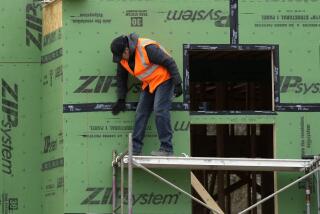California unemployment rises as private hiring slows and state government payrolls tumble

California’s labor market weakened at the end of summer, with the unemployment rate ticking up again and the state eking out a small number of new jobs, according to new data released Friday.
The statewide unemployment rate went up a notch to 5.3% in August (from 5.2% in July), tied with Illinois for the second highest behind Nevada’s 5.5% rate, the U.S. Bureau of Labor Statistics said. The nation’s jobless figure, as previously reported, edged down to 4.2% last month.
Although California posted solid job gains last month in healthcare and in leisure and hospitality, employment fell back in other key parts of the state’s economy, including the beleaguered motion pictures industry, tech and manufacturing.
Lower interest rates will ultimately help with credit card and real estate purchases, but it may take months for these benefits to seep to consumers.
And significantly, the public sector in California, which had been a reliably sturdy source of employment growth, lost jobs last month for the first time in more than a year. The drag came from a strikingly big loss in state government payrolls, which analysts attributed to Sacramento’s budget woes.
“The drop this month reflects mainly the hiring freeze first announced by the governor in the spring,” said Michael Bernick, a former director of the state’s Employment Development Department who has been following California government trends since the late 1970s. “No layoffs have been imposed,” he said, “but vacant positions generally are not being filled as employees retire or leave state government.”
For most of the last three decades, Sacramento has been adding jobs like clockwork, its payrolls growing from about 400,000 in 1995 to 580,000 in July before declining by 17,100 last month.
“Whether this drop reflects any long-term change in the growth trajectory of state government will depend on the tenure of the freeze, the state budget politics and policy decisions,” Bernick said.
California employers, overall, added on net 6,800 new jobs in August. That was well below the state’s monthly average of 17,750 this year and its population-based share of the nationwide August gain of 142,000.
Nationally, hiring has been slowing and job opportunities shrinking. Those were major factors in the Federal Reserve’s decision Wednesday to slash interest rates for the first time since 2020 and the string of rate increases imposed to reverse the post-COVID-19 inflation surge.
The unusually large, half-point rate reduction is expected to be the first in a series of cuts, aimed at helping keep the economy and the labor market from foundering.
The number of unemployed people in the U.S. has grown by 775,000 over the last year, to more than 7.1 million. In California there were more than 1 million jobless workers as of August. A disproportionately large number of them are younger workers, said private consulting firm Beacon Economics.
California’s relatively high and rising unemployment rate also may reflect the surge in immigration that has added to the labor pool.
Fed interest rate changes can take months to filter through to consumers and the broader economy, but they could give a more immediate boost in confidence to businesses, which may help firm up near-term employment. Reflecting the increased optimism, investors have bid up stock prices this week.
Lower interest rates should give a lift to California’s housing market, which has been held back by relatively high mortgage rates and steep increases in home prices. Employment in construction was flat in August, as it was for the real estate sector and financial services more broadly.
The state’s film industry remained lackluster. Motion pictures employment in Los Angeles County dipped below 100,000 in August.
L.A. County’s unemployment rate overall went up to 5.6% in August from 5.5% the previous month and 5.1% a year earlier.
Regionally, job gains last month were led by the Central Valley, according to Beacon Economics. In Southern California, the Inland Empire and San Diego posted the largest increases.
More to Read
Inside the business of entertainment
The Wide Shot brings you news, analysis and insights on everything from streaming wars to production — and what it all means for the future.
You may occasionally receive promotional content from the Los Angeles Times.












